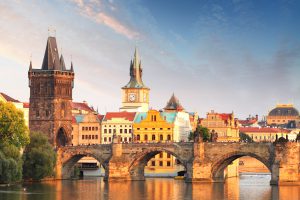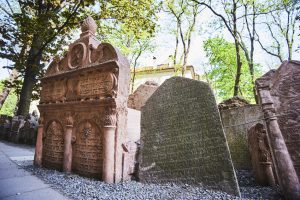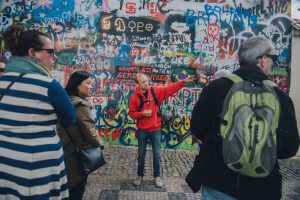Special Places to visit in Prague
Special Places in Prague
After you have familiarized yourself with Prague (more info at Prague Tours) – the Little Quarter, Prague Castle, and the Old Town, we recommend you visit the following special sights.
Charles Bridge at night
 Avoid the crowds that flock to the Charles Bridge during the day, and take a tranquil walk across the bridge, admiring the 30 mostly Baroque statues and statuaries created by master Baroque sculptor Matthias Bernard Braun. The views of illuminated Prague Castle, the Little Quarter, the Old Town, and the National Theatre are breathtaking. Legend says that the bridge, commissioned by Holy Emperor Charles IV in the early 15th century, is made of lime with egg. More than 620 meters long, the bridge measures almost 10 meters in width. This not-to-miss sight was the only bridge over the Vltava River from the 15th century until 1841.
Avoid the crowds that flock to the Charles Bridge during the day, and take a tranquil walk across the bridge, admiring the 30 mostly Baroque statues and statuaries created by master Baroque sculptor Matthias Bernard Braun. The views of illuminated Prague Castle, the Little Quarter, the Old Town, and the National Theatre are breathtaking. Legend says that the bridge, commissioned by Holy Emperor Charles IV in the early 15th century, is made of lime with egg. More than 620 meters long, the bridge measures almost 10 meters in width. This not-to-miss sight was the only bridge over the Vltava River from the 15th century until 1841.
Jewish Museum
 All visitors to Prague should visit the Jewish Museum, no matter how short their stay may be. It includes four synagogues, the Old Jewish Cemetery, and the Ceremonial Hall. Perhaps the most striking sight of the quarter is the Old Jewish Cemetery. Come here as soon as it opens to avoid the crowds and soak in the atmosphere. There are 12,000 crooked tombstones piled on top of each other, and everyone has their own story to tell. Overall, there are approximately 100,000 bodies in this burial ground that was used from 1439 to 1787. The Old-New Synagogue – is not included on your museum admission ticket! – it is the oldest synagogue in Central Europe and one of Prague’s first Gothic buildings as it was constructed in 1270. The Maisel Synagogue, used during the Occupation as a warehouse of Jewish treasures that Hitler planned to exhibit in his Museum of the Extinct Jewish Race, now offers a permanent exhibition of Jewish history in Bohemia from the 10th to the 18th century.
All visitors to Prague should visit the Jewish Museum, no matter how short their stay may be. It includes four synagogues, the Old Jewish Cemetery, and the Ceremonial Hall. Perhaps the most striking sight of the quarter is the Old Jewish Cemetery. Come here as soon as it opens to avoid the crowds and soak in the atmosphere. There are 12,000 crooked tombstones piled on top of each other, and everyone has their own story to tell. Overall, there are approximately 100,000 bodies in this burial ground that was used from 1439 to 1787. The Old-New Synagogue – is not included on your museum admission ticket! – it is the oldest synagogue in Central Europe and one of Prague’s first Gothic buildings as it was constructed in 1270. The Maisel Synagogue, used during the Occupation as a warehouse of Jewish treasures that Hitler planned to exhibit in his Museum of the Extinct Jewish Race, now offers a permanent exhibition of Jewish history in Bohemia from the 10th to the 18th century.
The Lennon Wall
 Velkopřevorské Square, Malá Strana (Little Quarter). The Lennon Wall used to be a place where youth wrote down their complaints about totalitarian life. John Lennon’s music and all western pop songs were banned before the Velvet Revolution, and youth dissatisfied with Communist society idolized this American legend. Lennon’s portrait appeared on the wall when he died in 1980, but it has long since disappeared under new layers of paint. Youth who dreamed of freedom and democracy could have been imprisoned for their anti-Communist scribblings during the totalitarian era. Now the wall symbolizes love, peace, and freedom of speech.
Velkopřevorské Square, Malá Strana (Little Quarter). The Lennon Wall used to be a place where youth wrote down their complaints about totalitarian life. John Lennon’s music and all western pop songs were banned before the Velvet Revolution, and youth dissatisfied with Communist society idolized this American legend. Lennon’s portrait appeared on the wall when he died in 1980, but it has long since disappeared under new layers of paint. Youth who dreamed of freedom and democracy could have been imprisoned for their anti-Communist scribblings during the totalitarian era. Now the wall symbolizes love, peace, and freedom of speech.
Lobkowicz Palace
Situated on the grounds of Prague Castle, this museum traces not only the history of the Lobkowicz family but also the history of the Czech lands. Thanks to the superb audio guide, you will feel as if you know the intriguing Lobkowicz ancestors in the many portraits. The Lobkowiczes lost all their property, including 13 castles, when the Nazis took over. After the war, all of their property was returned. Then, when the Communists came to power in 1948, Max Lobkowicz lost everything again. The family did not get their properties back until after the 1989 Velvet Revolution. You’ll learn how classical music and art played major roles in the family’s history. Original scores by Beethoven are not to be missed. The fascinating works of art include masterpieces by Pieter Brueghel the Elder and Antonio Canaletto.
Letná Park
This 15-hectare park offers superb views of the Vltava River. Perhaps it is best known as the former site of the 15-meter high statue of Joseph Stalin and his entourage, a colossal monument that stood there from 1955 to 1962. Czechs joked that the sculpture resembled a line for meat. The statue is long gone, however, and a metronome has stood in its place ever since the Centennial Exhibition of 1991. A Czech king had his coronation on Letná in the 13th century, and the park was the site of one of the major demonstrations of the Velvet Revolution in 1989. The park includes the Hanavský Pavilion, a pseudo-Baroque structure, and a small chateau showing off a Neo-Renaissance look. Restaurants are located there. An Expo 58 pavilion designed after the 1958 World’s Fair Exhibition in Brussels offers splendid views of the city.
Museum of Communism
Tracing the history of Communist rule in Czechoslovakia from the Party’s founding in 1921 to the 1989 Velvet Revolution that toppled the totalitarian regime, the museum offers a pictorial and written narrative in three sections called The Dream, The Reality, and The Nightmare. You will see an almost empty shop with only soup and cocoa on the shelves. A telephone won’t stop ringing in an interrogation room. There is also a wooden telephone box lacking a phone. A film shows police beating demonstrators at protests that led to the end of totalitarian rule in Czechoslovakia.
The Vrtba Garden
Karmelitská Street 25/373-III. Created from 1715 to 1720, the Vrtba Garden is Baroque at its best. Prague architectural guru František Maxmilián Kaňka designed this small but steep Italian-style palace garden with three levels. The highest section offers unique, romantic views of the city. Take a stroll while gazing at the statuary by Baroque master sculptor Matthias Bernard Braun, whose works can also be seen on the Charles Bridge. Frescoes by Václav Vavřinec Reiner also amaze. At the entrance gate, you will be greeted by Atlantis carrying a globe and two allegories of abundance and wealth, also courtesy of Braun. The woody plants and flowers are also fascinating and include white cedars, European yews, roses, and perennials.
Wallenstein Gardens
Valdštejnské Square 4/17-III. Located on the grounds of the palace housing the Czech Senate, these gardens hail from as far back as 1620 to 1630, when Wallenstein Palace was erected. They display Mannerist features. The gardens include a circular grotto and huge sala terrena adorned with frescoes showing mythological themes. Elegant statues also portray characters from mythology. A bronze statue of Venus and Cupid stands in the middle of a marble fountain. You will also see magnolias, fig-trees, a field maple, ginkgo, and honey locust. The nearby riding hall hosts dazzling art exhibitions. Don’t miss the chance to go for a walk on nearby Kampa Island, where you can see museums, a park, and picturesque streets, as well as dine-in in top-notch restaurants.
National Technical Museum
This often-overlooked museum hails from 1908. It contains 14 permanent exhibitions, including transportation, architecture, construction and design, mining, metallurgy, and astronomy, as well as printing and photographic techniques. The astronomy exposition features a 5,000-year-old meteorite and devices used in that field from the 15th through the 20th century. The transportation section is fascinating with its automobiles that ran on combustion and steam engines, gliders, and unique historical airplanes, for example. Set your eyes on the first automobile made in the Czech lands and the Tatra 80 automobile from 1935 that was used by the President of the First Czechoslovak Republic, Tomáš Garrigue Masaryk.
Two installations by David Černý
The Head of Franz Kafka (The Metamorphosis)
Contemporary artist David Černý’s shocking and provocative sculpture of a huge silver head consists of 42 moving layers that rotate 360 degrees and occasionally align to resemble Kafka’s head. The installation weighs 39 tons and is 11 meters high. It is situated in front of the Quadrio shopping center near the Národní třída Metro station.
Horse
Another stunning installation by Černý is his “Horse,” which features an equestrian statue of Saint Wenceslas. This one is a far cry from the statue of the Czech patron saint on Wenceslas Square, though, as Černý’s Wenceslas is riding an upside-down dead horse. It is located in the Lucerna passage near the Lucerna movie theatre, a beautiful old theatre that will take you back in time if you have the chance to catch a movie there.
Cathedral of Saints Cyril and Methodius
Now a house of prayer for the Orthodox Church of the Czech Republic and Slovakia, the cathedral perhaps is best known for its crypt, now a museum. This was the place where four parachutists took refuge while the Nazis hunted them in retaliation for their assassination of high-ranking Nazi Reinhard Heydrich as they fulfilled their task in Operation Anthropoid. Armed with only pistols, the resistance fighters in the crypt fought a lengthy battle against more than 700 Nazi soldiers, who tried to smoke them out and then flooded the space. When they realized all was lost, the four patriots committed suicide. The cathedral is located in New Town.
Prague Zoo
With ten pavilions and 150 expositions, the zoo houses about 5,000 animals. It takes up 45 hectares. The fascinating Indonesian jungle was constructed in the early 2000s and held the distinction of being the biggest pavilion for animals in the history of Czech zoos. The African House and Savannah are home to giraffes, zebras, and ostriches, while penguins have a pavilion all to themselves. At the zoo, you will see a pair of the biggest lizards in the world, Komodo dragons, orangutans, kangaroos, endangered species of crocodiles, antelopes, flamingos, and much more.
Hotel Jalta
This hotel is a well-known example of socialist architecture, but it is what is underneath the hotel that is the Jalta’s most intriguing feature – an anti-nuclear bunker that covered three floors. Constructed in the 1950s, it was made to protect about 150 high-ranking Communist officials in the event that a nuclear war broke out. Instead, the Secret Police occupied the space for four decades. Composed of several rooms, the Museum of the Cold War displays listening devices of the Secret Police as the authorities eavesdropped on hotel guests and employees. You’ll see Communist propaganda, gas masks, and a 1950s-era machine gun. The tour, led by a man dressed in the uniform of a Czechoslovak army officer during the 1980s, also provides insight into the history of the Cold War itself.
Cimrman English Studio at Žižkov Theatre of Jára Cimrman
Now English speakers can laugh along at the witty and uniquely Czech humor in the plays of Jára Cimrman, based on a fictional character who was selected as the Greatest Czech in a 2005 survey. The personality of Jára Cimrman remains one of the greatest influences on Czech culture and folklore. Cimrman was an innovator in many walks of life: he was an inventor, a philosopher, a traveling dentist, a criminologist, a world traveler, and a self-taught gynecologist as well as a prolific writer of plays, fairy tales, novels, poetry, and operettas. Unfortunately, he was unlucky – so unlucky that his works did not receive recognition until 1966 when the Czech ensemble was created. While the Czech plays have been performed to sold-out audiences for more than 50 years, English speakers can choose among three titles – Pub in the Glade, The Stand-In, and The Conquest of the North Pole.


